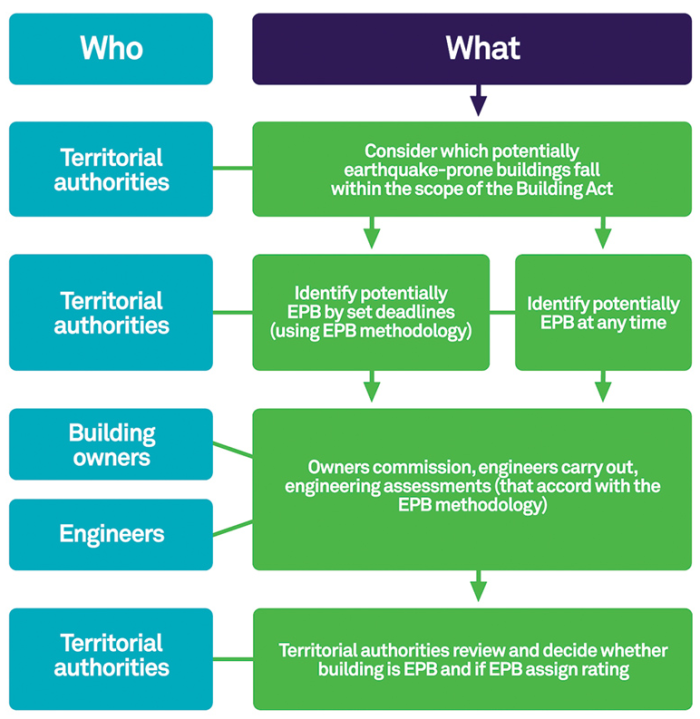The information on this page is intended to let you know about the changes in legislation relating to earthquake-prone buildings. As Horowhenua District Council moves forward with its processes this section will be updated to reflect actions taken and next steps.
Horowhenua District Council has sourced the following information directly from www.building.govt.nz, the Ministry of Business, Innovation and Employment's Building Performance website, licensed under a Creative Commons Attribution 4.0 International License.
New Zealand is extremely prone to seismic activity and ensuring the safety of people is paramount. Buildings need to be safe for occupants and users.
The Building (Earthquake-prone Buildings) Amendment Act 2016 introduced major changes to the way earthquake-prone buildings are identified and managed under the Building Act. It uses knowledge learned from past earthquakes in New Zealand and overseas.
The system which came into affect on 1 July 2017 is consistent across the country and focuses on the most vulnerable buildings in terms of people's safety.
It categorises New Zealand into three seismic risk areas and sets time frames for identifying and taking action to strengthen or remove earthquake-prone buildings.
Horowhenua has been identified as a High Risk Seismic area which affects the timeframes for identification and remediation of Earthquake-prone buildings.
More information can be found on the Ministry of Business, Innovation & Employment's (MBIE) Building Performance Managing earthquake prone buildings page.
A building, or part of a building, is earthquake prone if it will have its ultimate capacity exceeded in a moderate earthquake, and if it were to collapse, would do so in a way that is likely to cause injury or death to persons in or near the building or on any other property, or damage to any other property.
Council will determine if a building or part of a building is earthquake prone using the EPB methodology, a document which sets out how territorial authorities identify potentially earthquake-prone buildings, how engineers undertake engineering assessments, and how territorial authorities determine whether a building or part is earthquake prone, and if it is, its earthquake rating.
More information can be found on MBIE's Building Performance Managing earthquake-prone buildings page about:
Experience from Christchurch and overseas has shown that the failure of earthquake-prone buildings, or parts, can endanger lives. Thirty-nine people lost their lives when unreinforced masonry buildings failed during the Christchurch earthquake on 22 February 2011. Earthquake risk reduction is a priority in New Zealand.
New Zealand has had a progressive approach to improving standards for new buildings and earthquake-resistant design since design standards for buildings were first introduced into New Zealand in 1935, following the Napier earthquake.
Advancements in the knowledge of seismicity, material properties and the response of buildings in earthquake shaking has resulted in progressive refinements to requirements for the design and detail of buildings.
The system introduced on 1 July 2017 provides leadership and direction on how to manage the risks to public safety posed by existing buildings, including those constructed prior to the introduction of certain design standards.
More information can be found on MBIE's Building Performance Managing earthquake prone buildings page Why buildings are managed for earthquake risk
The system for managing earthquake-prone buildings targets buildings and parts of buildings that pose the greatest risk to public safety or other property in a moderate earthquake event.
Helpful information about the system can be viewed below:
Knowing and understanding the system for managing earthquake-prone buildings is important for everyone. The focus of the system is protecting people from harm in an earthquake.
Read more about roles and responsibilities below.
Territorial authorities and earthquake-prone buildings
Council plays a key role in the new system for managing earthquake-prone buildings.
Engineers, other building professionals and earthquake-prone buildings
Engineers will be commissioned by building owners to undertake assessments of potentially earthquake-prone buildings. Engineers and other building professionals will need to advise and assist building owners, who must obtain assessments and complete seismic work on their earthquake-prone buildings within set time frames.
Owners of potentially earthquake-prone buildings
Owners of buildings must take action within set time frames if their building is considered to be potentially earthquake prone or determined as earthquake prone and an EPB notice is issued.
Users of earthquake-prone buildings
If you use or occupy an earthquake-prone building, or live or work in an area where there are earthquake-prone buildings, the system will give you better information about how a building is expected to perform in an earthquake.
Territorial authorities, engineers and buildings owners have key responsibilities for managing earthquake-prone buildings (EPBs). This is outlined in the diagram below.
Who does what when managing earthquake-prone buildings
